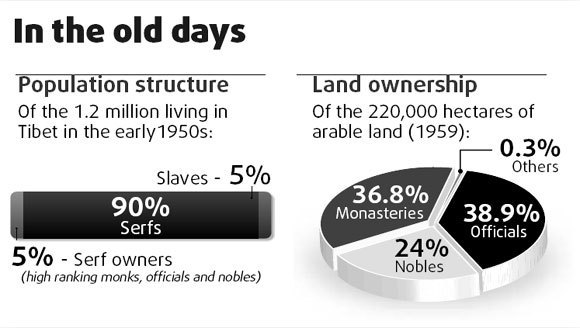 |
|
|||||||||||||||
| | 网站首页 | 英语新闻 | 英语学习中心 | 英语图片 | 下载 | 购书 | 培训 | 留言 | Study Chinese | | ||
|
|
||
|
||
 |
|
|||||||||||||||
| | 网站首页 | 英语新闻 | 英语学习中心 | 英语图片 | 下载 | 购书 | 培训 | 留言 | Study Chinese | | ||
|
|
||
|
||
|
|||||
Documents present picture of Tibet |
|||||
| 作者:soosun 新闻来源:www.51education.net 点击数: 更新时间:2008-4-13 | |||||
|
One sentence in Article Three of the Thirteen Laws, a copy of which is filed under the No MB101 in the Archives of the Nationalities Cultural Palace, reads: "Persons of low social stratus who quarrel with those of high status shall be arrested".  The eighth article of the Thirteen Laws says: "A drop of blood of the people of high status is worth one qian (0.16 oz) of silver, while a drop of blood of the people of low status is worth one li (one 10th of a qian) of silver". Figures from the old Tibetan local government from June 1959, which are kept at the Tibet autonomous region's archives, show that of the 3.3 million khals (in Tibetan measurements, about 541,200 acres) of land under cultivation in old Tibet, local government officials owned 1.2 million, or about 39 percent; aristocrats owned 790,000, or 24 percent; and the high clergy owned 1.2 million, or 37 percent. These "manorial lords", accounted for just 5 percent of the population. The serfs and house-slaves who accounted for 95 percent of the population were the property of serf owners. Even their offspring became the property of the serf owners from birth. According to many original contracts preserved in the Archives of the Nationalities Cultural Palace and the Archive of the Tibet Autonomous Region, the manorial lords had the freedom to exchange serfs or present serfs to each other as gifts. Serfs had to pay high interest on their debts by doing corvee (unpaid labor) or by selling their own children. A certificate, written in the old form of the Tibetan language, used before 1959 and kept as No MC 1015 File at the Archives of the Nationalities Cultural Palace, reads: "Being unable to pay back the money and grain we owe Nedong Dekhang, we, Tsewang Rabten and my wife, serfs of the Dusong Manor, must give up our daughter Gensong Tonten and younger son Padma Tenzin to Dekhang to repay the debts. The descendents of their son and daughter will be Dekhang's serfs." Part of another contract, also kept at the Archives of the Nationalities Cultural Palace, as No MC 10144 File, was signed in 1947 by Drashi Choda to pay off his debt by letting his sister Tsering Lhamo work for Lharang without pay for 10 years. It reads: "I, Drashi Choda, belong to the Nari Monastery of the Nari Manor. I borrowed 34 khal (about 1,047 pounds) and 3 sheng (0.085 bushels) of grain from the Lharang granary in the Wood-Monkey year, the interests of which amount to 6 khal (184 pounds) and 14.5 sheng (0.41 bushels). The principal and the interest total 40 khal (1,232 pounds) and 19.3 sheng (0.49 bushels) of grain. "As I am unable to pay back the sum annually, I ask my younger sister Tsering Lhamo, who shares weal and woe with me, to pay off my debts by doing 10 years' unpaid service for the Lharang beginning at the first day of the 12 month of this Fire-Dog year." The contract also stipulates: "In case of violation of the contract, Drashi Choda shall be punished according to the local law." According to old Tibetan administration records of 1950, kept at the Archive of the Tibet autonomous region, 90 percent of Tibet's 1 million people were homeless. Of the 20,000 in Lhasa at the time, more than 1,000 families lived as beggars.
Some serf owners tortured their slaves by chopping off their feet and hands, gouging out their eyeballs, cutting off their tongues or pushing them off cliffs. They could do this legally, because they were protected by the Thirteen and Sixteen Laws.
Article Four of the Thirteen Laws stipulated: "Those who loot, kidnap, steal and kill, commit armed robberies or rebel against the authorities shall be punished corporally by: gouging out the eyes; cutting off the foot, tongue or hand; being pushed off a cliff; drowning; or execution."

|
|||||
|
新闻录入:soosun 责任编辑:51education
|
|||||
|
|
|||||
| 【发表评论】【加入收藏】【告诉好友】【打印此文】【关闭窗口】 | |||||
| 最新热点 | 最新推荐 | 相关文章 | ||
| 奥斯卡主持打貌美牌 新老影星… Victoria's Secret supe… 温哥华蝉联全球最宜居城市榜… 白宫首次任命“男同”为社交… 华裔“虎妈”教育方式引争议 第83届奥斯卡奖提名完全榜单… 经济不景气 美新人流行在殡仪… 英准王妃透视裙走红 或升值至… 西班牙女子登记太阳为私产 要… 《时代》百人榜揭晓 克林顿、… |
| 网友评论:(只显示最新10条。评论内容只代表网友观点,与本站立场无关!) |
| |Sitemap地图 | 设为首页 | 加入收藏 | 联系站长 | 友情链接 | 版权申明 | 网站公告 | 管理登录 | | |||
|